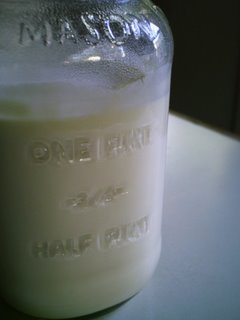Getting Cultured

As you watch the store shelves burgeon with the bounty of fresh summer fruits -- plump blueberries, succulent strawberries, and soft, juicy peaches -- it becomes nearly impossible to avoid bringing a plethora of these treasure home, regardless of considering how or when you will eat them.
While a bowl of fresh fruit is certainly satisfying, it seems human nature to want to combine fruit with cream. Typical choices, of course, are ice cream, yogurt, whipped cream, or just cream. While that is fine and good, there is a further way to delight in the fruit and cream combo, and one which is probably more appetizing to anyone who may be lactose intolerant: crème fraîche.
Crème fraîche is a cultured cream product that you can easily make at home. You can whip it up like you would whipping cream and enjoy it on fruit, use it on other desserts that call for whipped cream (bearing in mind that it has a more sour flavor than whipped cream), or use it as a sour cream substitute.
Not only do the beneficial bacteria in cultured milk products help break down lactose, but they also appear to support immune function while they simultaneously out-compete harmful bacteria and yeast.
Crème Fraîche
2 cups of pasteurized, but not ultra pasteurized heavy cream
1 to 2 Tablespoons of cultured buttermilk
Add the buttermilk to the cream in a saucepan and slowly heat, while stirring, to 85° F. Pour into a sterile glass jar. Let sit at room temperature, loosely covered, for 8-12 hours. As the buttermilk cultures grow in the cream you will notice it thickening. After it has incubated for the given period of time, refrigerate for about 24 hours before using.
Whipping Crème Fraîche
Proceed as you would when whipping cream -- add vanilla, sugar to taste, and possibly lemon or lime zest plus maybe a touch of citrus juice.
We recently had whipped crème fraîche, with lime zest, on a fruit salad composed of organic strawberries, pineapple, and papaya. I highly recommend it.

5 Comments:
I wonder what that would be like using a blue cheese culture. Any thoughts..
Honestly, I have no idea, but I would imagine rather sharp. Maybe worth an experiment, although I'm not sure what temperature you would need to maintain in order to incubate the blue cheese culture (when you make yogurt the ideal temperature is 110 F). You can also make creme fraiche with sour cream instead of buttermilk starter, though apparently most people prefer the taste of the buttermilk version.
The creme fraiche was great on white rasberries and the next night we had it on strawberries!
Hey Jade.. please note a new link for my community and organic gardening pix. It will require alot more work to get it up to speed but I am sending you the link so that you can watch this movement grow right from seed. hehe
http://petersoncreekcommunitygardens.blogspot.com/
Hey ericswan, I tried to visit your new blog, but it doesn't seem up yet. I guess I will have to wait. Looking forward to it though.
Post a Comment
<< Home